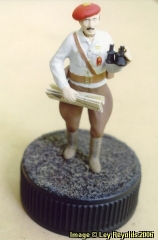Our resident Iberian Expert (Ibericist??), Senor Ley Reynolds (Leo Reynaldo?) ponders the subject of modelling on the move, and comes up with some useful suggestions.
My current occupation leads me to be away from home about one week each month, added to which our holidays for the past few years have involved overseas flights of 12 to 24 hour duration. This adds up to a fair amount of time to be away from the workbench, so I always carry a project or two with me – but these must be carefully selected and size is important!
Construction of a 1:72 Short Sunderland while traveling is not really practical and any project which requires a blade is out of the question of aircraft these days (no scratchbuilt 1:72 Spanish Civil War armoured trucks then!).
For me, the answer has been 1:35 scale figures, with a Spanish Civil War theme, of course!! The components take up little space, and emery boards, wet’n’dry and filler in the aircraft cabin. Assembly requiring glue of any sort I leave to be done in the overnight accommodation, otherwise restricting myself to cleaning up components, filling and sanding whilst “on the move”.
The following images show one of my results to date, and I have had no problems – apart from a deal of amusement on the part of various airline “hosties” and hotel maids.
Teniente, Requete de la Columna Redondo
The Requetes, identified by their red berets, were the militia of the Carlists. This movement was (and presumably still is) composed of supporters of Don Carlos and his heirs, as claimant to the Spanish throne. They mostly resided in the north and northeast of Spain.
Two unsuccessful rebellions, the First (1834-39) and the Second (1870-72) Carlist Wars, did little to weaken the movement and the Requetes provided fanatical shock troops for the Nationalist Army in the Spanish Civil War. Not unnaturally, they suffered disproportionately high casualties.
The Model
As the images show, this figure was constructed from components taken from various WWII Soviet and German figure sets, suitably modified to achieve the desired posed. White Milliput was used to make the flared trouser legs, fill out the jacket and make the beret. Pouches were made from polystyrene rectangular section, detailed with stretched sprue. Belts and braces were made from plasticard, softened with liquid glue to conform to the shape of the torso.
The figure was painted with Humbrol enamels, although I have come to believe that acrylics may be better for flesh tones.
Text and Images © Ley Reynolds 2006








